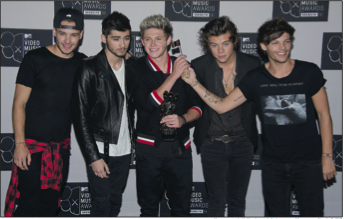Celebrities change, trends survive
Teen heartthrobs have long dominated the sphere of popular entertainment. Headshots tattooed with bold headlines tactically aimed to intrigue the “pre- teen” and teenage demographics still tempt shoppers in checkout lines, usually becoming the impulse buy at the end of the conveyor belt in 2014. Simply mentioning names like Zac Efron, Niall Horan and Dylan O’Brien brighten the mood of the stereo- typical high school female.
However, crushing on the newest teen pop sensation isn’t a new concept, rather a continuation of a phenomenon that has survived the departing of decades, a metamorphosis of style and transition of trends. The 70s persist as a decade honored by nostalgia, the last true decade of creativity in an America not plagued by such corporations as Wal-mart. John Travolta, Patrick Swayzee, David Cassidy Just as decades before and after, TV, movie and pop music stars claim spots on center- folds and the walls of a “far out” youth.
One cannot address the prevalence of heartthrobs without mentioning fan bases, and in 2015, “Directioners” reign su- preme. Screaming mobs of girls obsessed with the boy band originally created by The X Factor’s Simon Cowell swarm at any and every opportunity to catch a glimpse of Niall, Harry, Zayne and Louis.
“I like to think I keep the act of fan-girling pretty low key,” Lauren Lastres, junior, said.
It was the group’s sense of normalcy and catchy music that originally attracted Lastres and a group of her friends.
“They were staying at the Grand Hyatt this past October for the Raymond James concert and some of my friends got a hotel room there,” Lastres said. “They waited for a suspicious looking car to leave and then they followed and it worked for a little.”
70s pop star David Cassidy, the world’s highest paid solo performer by age 21 at the time, developed a similar following that was said to surpass even that of The Beatles. Cassidy’s fan base has evolved from masses of groupies outside venues to communities of fans on the Internet where his dreamy legacy survives.. In the –70s, the first Cassidy following collected under the name “David’s Girls Against Disease.” Today, his fan still meet as members of “The Official David Cassidy Fan Club.”
Cassidy starred in the role of Keith Partridge, eldest son on “The Partridge Family,” a musical sitcom about a widowed mother and her five children who start a band and road trip across the country in a school bus. After its cancellation in 1974, Cassidy broke out as a solo act and rose in status to an idolized teen icon with hits like “I Think I Love You” and “Lyin’ to Myself.”
Achieving stardom as a double threat, includes dual talent of singing and acting Star of today Zac Efron first emerged as a Disney star in “High School Musical.” After two subsequent musicals following the original pitch of a sport’s star teenage love drama, Efron continued on to play roles in films such as “Hairspray,” “17 Again” and “Charlie St. Cloud.”
Most recently, Efron starred alongside Dave Franco as a scheming frat boy in “Neighbors,” which received a 73 percent rating by movie critics on Rotten Tomatoes.
“High School Musical made me realize he’s a cool actor, an okay singer, a bad dancer, but very hot.” Zoe Gholson, sophomore, said.
Despite this, Gholson admitted her favorite Efron movie was “That Awkward Moment.”
“His character was just so sweet to the girl and his lines were super funny.” Gholson said.
Nearly 30 years prior, star John Travolta began a similar path to stardom, also playing an attractive high schooler who develops a habit of breaking out into song in the iconic movie “Grease” released in 1978.
The romance targeted the teenage audience and immediately attracted an almost cult-like following. Even after his days as a slicked-back heartthrob, Travolta starred in over 70 feature length films, dabbled in producing, tele- vision and more. His most notable role was in Quentin Tarantino’s “Pulp Fiction,” one of the most highly acclaimed movies of all time.
Though the names and faces of heartthrobs have changed from the 70s to now, the characteristics, such as striking good looks, mu- sical talent and colorful personality remain the same, feeding the powerful attraction to the concept of deitizing entertainers.

